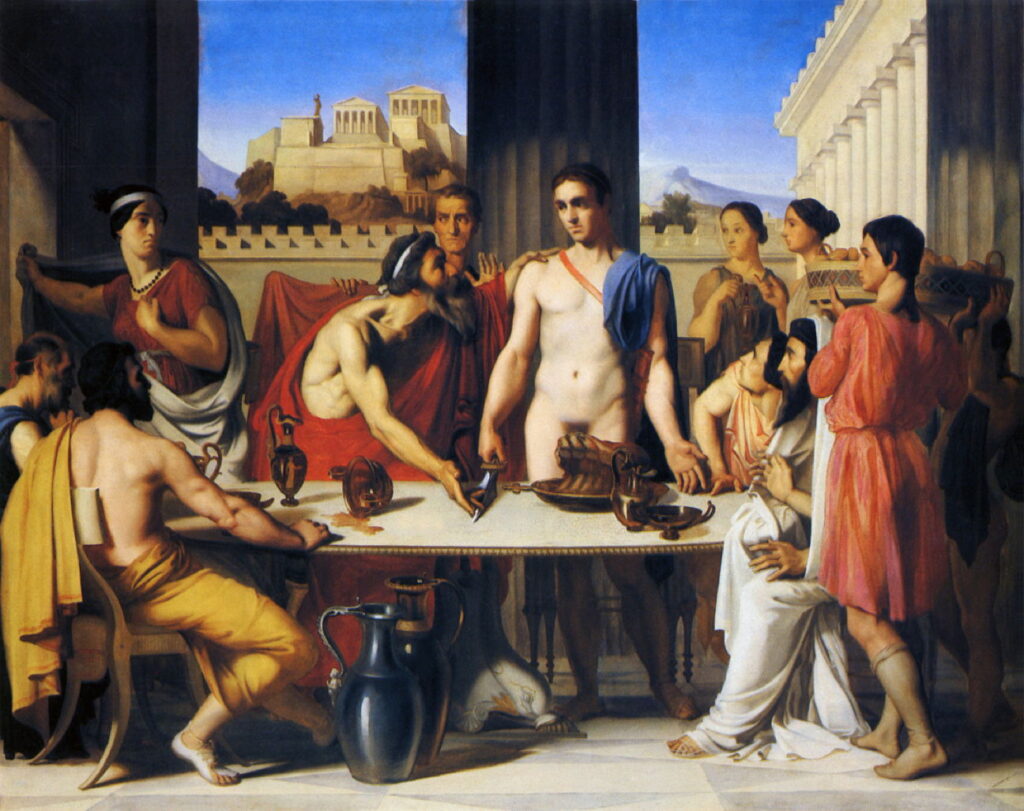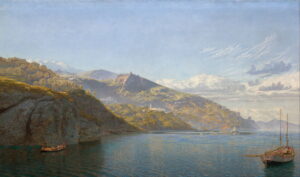Changing Paintings: 33 The origins of Theseus

Ovid tells one final story about the downfall of Medea after she has married King Aegeus in Athens, linking back to the saga of Jason, and forward to his next thread telling the story of Theseus. As this brief bridge only hints at the early life of Theseus, I here provide a more detailed account of his origins.
Aegeus had been childless, but following the prophecy of the oracle at Delphi, the King of Troezen got him drunk and packed him off to bed with his daughter Aethra. She had been instructed in a dream to leave Aegeus asleep, and to go to a nearby island, where she was also impregnated by the god Poseidon. Theseus, who was presumed to have been conceived that night, was thus considered to have double paternity, by god and man, a common qualification for mythical heroes.
Aegeus returned to Athens, after burying his sword and sandals under a massive rock. He told Aethra that when his son grew up, she should tell him to move the rock as a test. If he succeeded, then he should take the sandals and sword as evidence of his paternity.
When Theseus was old enough, his mother Aethra showed him the rock, and gave him Aegeus’ instructions. Theseus moved the rock, found the sandals and sword, then undertook an epic journey overland to his father in Athens.
Laurent de La Hyre (1606–1656), Theseus And His Mother Aethra (1635-36), oil on canvas, 141 × 118.5 cm, Szépművészeti Múzeum, Budapest, Hungary. Wikimedia Commons.
One of the earliest depictions is Laurent de La Hyre’s Theseus And His Mother Aethra (1635-36). This shows the young Theseus lifting a heavy pillar to reveal a pair of shoes and a sword.
Nicolas Poussin (1594–1665) and Jean Lemaire (1598–1659), Theseus Recovering his Father’s Sword (c 1638), oil on canvas, 98 x 134 cm, Musée Condé, Chantilly, France. Wikimedia Commons.
In one of his rare collaborative paintings, Nicolas Poussin worked with Jean Lemaire to show the same scene, of Theseus Recovering his Father’s Sword, in about 1638. This shows a marked contrast between the two actors: Theseus, destined to be a great hero, looks rough and brutish, while his mother Aethra wouldn’t look out of place modelling for the Madonna.
Nicolas-Guy Brenet (1728–1792), Aethra Showing her Son Theseus the Place Where his Father had Hidden his Arms (1768), oil on canvas, 50.2 × 59.7 cm, Los Angeles County Museum of Art, Los Angeles, CA. Wikimedia Commons.
Nicolas-Guy Brenet’s more sketchy painting of Aethra Showing her Son Theseus the Place Where his Father had Hidden his Arms from 1768 adds a river god for good measure, and has Aethra giving Theseus his marching orders to go find his father.
Antonio Balestra (1666–1740), Theseus Discovering his Father’s Sword (c 1725), oil on canvas, 287 x 159 cm, Private collection. Wikimedia Commons.
In Antonio Balestra’s Theseus Discovering his Father’s Sword (c 1725) Theseus looks less enthusiastic to follow his mother’s directions.
Ovid’s story starts with the arrival in the court of King Aegeus of Theseus, who hasn’t yet been recognised by his father. Medea then tries to trick Aegeus to administer poisonous aconite to Theseus before his recognition, in a bid to keep Aegeus to herself. She prepares the poison in a cup which the king then offers to the young Theseus. At the last minute, just as his son is about to drink the aconite, Aegeus recognises that the sword borne by Theseus is his, knocks the cup away, and saves his son’s life.
In 1832, the theme chosen for the prestigious Prix de Rome contest was the moment that Aegeus recognised Theseus, immediately before the latter could swallow any of Medea’s poison. Two of the contenders for that great prize remain accessible today.
Antoine-Placide Gibert (1806-1875), Theseus Recognised by his Father (1832), oil, dimensions not known, Musée des Beaux-Arts, Bordeaux, France. Image by VladoubidoOo, via Wikimedia Commons.
In Antoine-Placide Gibert’s Theseus Recognised by his Father (1832), the three main actors are arranged almost linearly across the canvas. Just left of centre, Theseus stands, his head in profile, with the fateful cup in his left hand, and his father’s sword in his right. The king is just right of centre, looking Theseus in the eye, and appearing animated if not alarmed. At the far right is Medea, her face like thunder, sensing her plot to kill Theseus is about to fall apart.
Hippolyte Flandrin (1809–1864), Theseus Recognized by his Father (1832), oil on canvas, 114.9 × 146.1 cm, École nationale supérieure des Beaux-Arts, Paris. Wikimedia Commons.
It was Hippolyte Flandrin’s Theseus Recognized by his Father (1832) that won the Prix de Rome, with its more neoclassical look influenced by Jacques-Louis David. Flandrin establishes the scene as Athens, with a view of the Acropolis in the background. His timing is different from Gibert: this painting shows the moment immediately after Aegeus has recognised his son, and the cup of aconite lies spilt on the table. Theseus stands in the middle of the canvas conspicuously naked, his father’s sword held rather limply in his right hand. Aegeus stands to the left of centre, talking to his son quite emotionally. But of all the characters shown in this painting, it is Medea who is the most fascinating. Stood at the far left, she appears to be on her way out. She is po-faced, and looks as if she has come not from Greece, but from central Asia, perhaps.
Medea flees, never to be heard of again, leaving Aegeus to give thanks to the gods. Ovid then introduces Theseus with a short resumé of some of his accomplishments, including his killing of the Minotaur and of Procrustes, to be recounted later.
Paolo da Visso (1431–1481) Scenes from Boccaccio’s Teseida (date not known), front of a cassone, further details not known. Wikimedia Commons.
The myths of Theseus were at one time as popular as those of Heracles or even Aeneas or Jason. In about 1340-41, Giovanni Boccaccio wrote about them in his epic poem Teseida, or The Theseid. This in turn inspired The Knight’s Tale in Chaucer’s Canterbury Tales. Paolo da Visso (1431–1481) painted these three scenes from Boccaccio’s epic on the front of a cassone, the visual equivalent of Ovid’s catalogue of the adventures of Theseus.




